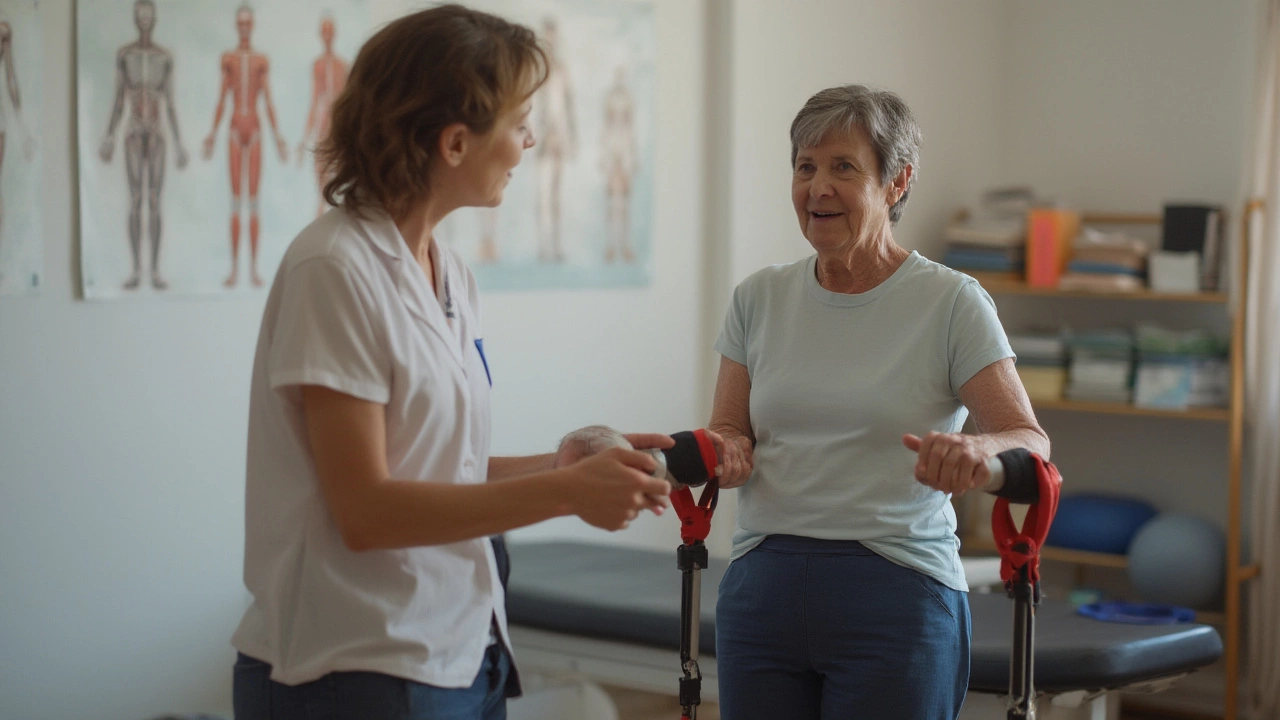 Jul, 16 2025
Jul, 16 2025
When you book your first physiotherapy session, your imagination might go wild. Will you be stretched like a pretzel? Asked to lift heavy weights? Or just sit and talk about your aches and pains? It’s not as mysterious as some think, but physiotherapy has a reputation for being a bit of an unknown until you’re lying on that table in your gym shorts. There’s more science, more planning, and way less pain—and a lot more humanity—than many expect. Some people come in thinking it’s just massage. Others picture grueling workouts. Very few are truly ready for the mix of detective work, practical assessments, and collaboration that real physiotherapy offers. Want to know what really happens, and not just what’s on the clinic brochure? That’s what I’m sharing today.
First Impressions: The Initial Consultation
The first time you sit down with a physiotherapist, the tone is low-key—think more detective, less drill sergeant. You’re not getting whisked onto a treadmill. Instead, the therapist wants the backstory. They’ll ask you what’s bothering you, when you first noticed it, and what patterns you’ve seen. Instead of a quick once-over, they want context—why you limped in today and how this pain changed your daily life. You’ll talk about specific details: Have you had accidents? Surgeries? What makes your pain better or worse? No two answers are the same, so they don’t rush.
Expect to fill out a short questionnaire. Some clinics use electronic forms, while others stick with the classic clipboard. If you have scans, X-rays, or doctor’s notes, bring them. They help the therapist understand the big picture. After talking, the physio will do physical assessments. They’ll check your posture, movement, strength, and flexibility. Sometimes, they’ll gently press on muscles or joints, watching how your body reacts. They might even check basic balance or reflexes.
This assessment isn’t just routine. It helps uncover the root cause—not just pain, but what triggers it. Maybe it’s worn shoes, a repetitive work motion, or sitting slouched all day. Often, people are shocked at how much detail this process reveals. For example, a University of Sydney study found that over 80% of people showed imbalances in movement they hadn’t noticed until assessed. You’ll likely hear things like, "Your hip muscles aren’t firing as they should," or "Your shoulder moves differently when you reach overhead." By the end of the first session, you and your therapist work out clear, realistic goals. Fancy a pain-free jog? Want to pick up your toddler without a creaky back? These get written down. The best therapists keep it real, talking about timelines and what you’ll need to do at home.
Hands-On Techniques: Beyond Massage
Most people are surprised that physiotherapy rarely means just lying there for a rubdown. Sure, manual therapy is popular, but it goes way beyond that. Therapists use their hands to mobilize joints, gently stretch muscles, or apply pressure to trigger points. This isn’t random. Each move is meant to restore movement or reduce pain.
Your physiotherapist might use techniques like joint mobilization, deep tissue release, or gentle manipulations. Some add in dry needling or soft tissue massage—especially if you’ve got lots of muscle tension or scar tissue. They may use heat, ice, or even ultrasound devices to help with healing. It’s tailored every time. A sprained ankle gets a different session than a frozen shoulder or post-surgery knee. Expect your therapist to walk you through what they’re doing. If something feels off, say so. That feedback matters—no tough-guy act needed.
What most folks miss is that these hands-on techniques are just one part of a bigger treatment puzzle. Manual therapy helps kick off healing, calms pain, or gets stiff joints moving. But your therapist is thinking long game. They want your muscles and joints to function on their own. That’s why you’ll never leave without being assigned at least a few stretches or movement drills to tackle on your own. Some therapists now even show you your movements on a screen—using motion analysis tools. One London clinic uses high-speed cameras to break down your walk or squat in slow-mo, showing where you lose form.
- Manual therapy relaxes tight muscles
- Joint mobilization can restore range of motion
- Massage targets scar tissue and chronic tightness
- Heat and ultrasound can speed up blood flow and recovery
The real gem is finding a therapist who explains things as they go—empowering you, not just treating you. If you want to learn something in every session, just ask questions. The best learning happens when you’re involved, not just the silent patient on the table.

Movement Is Medicine: Exercise & Rehab Plans
No getting around it: movement is the golden ticket in physiotherapy. The stretches, strengthening moves, and posture drills you do in the clinic and at home drive most of your progress. It’s way more personalized than any YouTube "fix your back" video. Your physio builds routines around what you can do right now, not what a pro athlete could handle. The exercises get tweaked as you improve—there’s no one-size-fits-all.
Think of your rehab session as half classroom, half gym. You’ll run through exercises targeting the muscles and movements that need work. If it’s your knee, you’ll get stability and strength drills. If your back is the issue, you might focus on core stability or hip mobility. The point isn’t to make you sweat buckets, but to groove healthy movement patterns until they come naturally. (Here’s a tip: The exercises that seem the easiest are sometimes the most important. Don’t skip them just because you can breeze through!)
Physios are trained to spot the tiny things—the way your foot rolls as you stand, how your back curves, or how your shoulder pinches. They’ll bring up cues like, "Feel your heel press down," or "Don’t let your knee wobble left." You get instant feedback and, if you’re lucky, a little humor to lighten things up. Rehab doesn’t have to feel heavy.
Progress doesn’t always show up immediately. Research from the Chartered Society of Physiotherapy shows that most people notice real changes within three to six sessions, especially when they stick to home exercises daily. Here’s where most people fall off—they skip homework. Therapists aren’t just being mean when they repeat the same instructions. They know strength and movement gain with small, repeated effort, not marathon gym days. Even if you’re skeptical, commit to the plan for a few weeks. Your body will thank you.
Here’s a quick look at a basic exercise plan example:
| Condition | Sample Exercise | Sets & Reps |
|---|---|---|
| Knee pain | Mini squats | 3 x 12 |
| Back pain | Pelvic tilts | 3 x 15 |
| Frozen shoulder | Wall walks | 2 x 10 |
| Ankle sprain | Ankle circles | 3 x 20 |
The magic isn’t in the exercise—it’s in consistency. If you hit a wall or lose motivation, bring it up in your next session. The therapist wants you to succeed, so don’t ghost them if things get tough.
Tech Tools and Gadgets: Not Just for Show
Modern physiotherapy uses tech in smart, practical ways. It’s not all exercise balls and resistance bands. You’ll see devices like electrical stimulation machines (to wake up muscles), ultrasound (to reduce swelling), or even virtual reality (for balance training). Don’t be shy—ask about any gear your therapist uses. Most are happy to show off how it helps you heal.
Newer clinics use handheld dynamometers to measure muscle strength, and apps to track your recovery step by step. Some even use wearable sensors so you can see your range of motion improve. For the data-lovers, your progress gets logged and charted, so it’s not just "feeling better"—you’re seeing actual numbers improve.
Light therapy tools are becoming common, especially for tendon or ligament injuries. And if you’re nervous about needles, dry needling feels nothing like a flu shot—it’s more of a quick tap to release a cranky muscle. Therapists check your tolerance and always explain the risks and rewards. According to a NHS audit, 94% of physiotherapy patients said tech gadgets made sessions easier to understand and more tolerable.
Sometimes, the coolest tool is surprisingly simple—therapists use mirrors so you can see your posture, or foam rollers for self-massage. Take the time to ask about DIY options that’ll fit your lifestyle. Even a rolled-up towel can double as a mobility prop at home. And if you’re a tracker at heart, see if your clinic has an app or portal where you can tick off home exercises and watch your progress. Sticking to the plan is easier when it feels more like a game and less like a chore.

Maximizing Your Physiotherapy: Pro Tips & What Really Works
Regulars know: Physio works best when you lean in, not check out. One session a week can’t outpace six days of skipping the rules. The annoying truth is, your body changes only when you build new habits outside the clinic. Keep a notebook or notes app handy for at-home reminders. Set up a routine—mornings, lunch breaks, evenings—whatever works for your schedule and stick with it.
Bored with the same moves? Tell your therapist. They want you to enjoy this process—giving you fun balance challenges, mini posture checks, or ways to fit exercises into daily routines. Even something as small as standing on one foot while brushing your teeth counts as balance work. (Try it tonight. You might be surprised by your wobbles!)
Next, listen for progress markers. Don’t just focus on pain. Maybe you walked up stairs without holding the railing, or you slept better, or hauled groceries with less puffing. These milestones matter as much as pain scores. Share them—your therapist uses success stories to tweak your plan.
If you hit setbacks—or the pain flares up again—don’t panic. The best therapists actually expect ups and downs. Your plan shifts as you improve, heal, or hit new challenges. Let your therapist know what’s really happening at home. Their advice is sharper when you’re honest.
- Stick to your physiotherapy session plan for long-term results
- Edit your workspace, shoes, or routines to support your therapy
- Ask questions—even the weird ones
- Celebrate small wins—tell your therapist about them
- Be patient—healing is rarely a straight line
You’ll probably be shocked at how many hidden habits shape your pain or health. From the way you carry a bag to how you rise from a chair, little tweaks stack up. Some therapists give video recaps or written summaries—save these, they keep you honest when motivation dips. And don’t go silent if the plan isn’t working. The best recoveries happen when you and your physiotherapist work as a team—adjusting goals, testing new tools, and finding what clicks for your unique body. Once you realize it’s about progress, not perfection, you’ll see why physiotherapy isn’t just for pro athletes or accident victims. Everyone stands to gain—from a longer dog walk to pain-free sleep, or just living without that itch to crack your back every five minutes.
